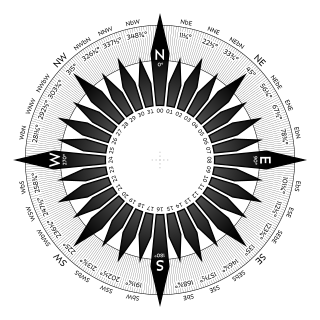
Back اتجاهات البوصلة Arabic Puntos del compás Spanish نامگذاری به ترتیب نقاط قطبنما Persian Rhumb French Penamaan titik utama kompas ID Kompásstrik Icelandic Румб Kirghiz Pemberian nama titik utama kompas Malay Kompasspunkt NN Rumb Polish

The points of the compass are a set of horizontal, radially arrayed compass directions (or azimuths) used in navigation and cartography. A compass rose is primarily composed of four cardinal directions—north, east, south, and west—each separated by 90 degrees, and secondarily divided by four ordinal (intercardinal) directions—northeast, southeast, southwest, and northwest—each located halfway between two cardinal directions. Some disciplines such as meteorology and navigation further divide the compass with additional azimuths. Within European tradition, a fully defined compass has 32 "points" (and any finer subdivisions are described in fractions of points).[1]
Compass points are valuable in that they allow a user to refer to a specific azimuth in a colloquial fashion, without having to compute or remember degrees.[2]
- ^ Evans, Frederick John, ed. (1859). "Notes on the Magnetism of Ships". Pamphlets on British shipping. 1785–1861. p. 8 (p. 433 of PDF). ISBN 0-217-85167-3.
A deviation table having been formed by any of the processes now so generally understood, either on the thirty-two points of the compass, the sixteen intermediate, or the eight principal points
- ^ Boardman, David (1983). Graphicacy and Geography Teaching. p. 41.
In particular they should learn that wind direction is always stated as the direction from which, and not to which, the wind is blowing. Once children have grasped these eight points they can learn the full sixteen points of the compass.